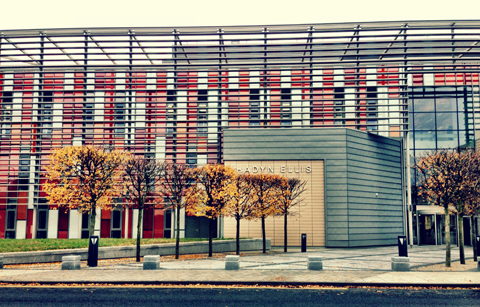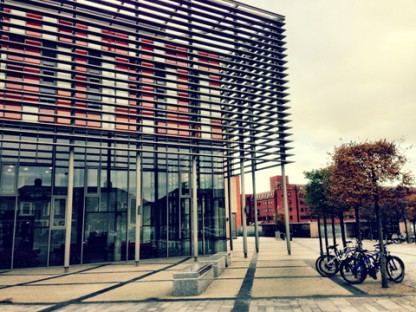Car fumes and cow farts aren’t all that’s to blame for climate change. In fact the melting ice caps and drowning polar bears are affected by something even more familiar, the buildings we spend our lives in every day.
Over 40% of the UK’s carbon emissions are produced by what architects call ‘the built environment’. As the problem of climate change grows so does the demand for sustainable buildings. The Hadyn Ellis building is the latest addition to the sustainable structures already scattered over the Welsh landscape.
 The Hadyn Ellis building in all its sustainable glory, though Andy Sutton believes the louvers facing north contribute more to the aesthetic than generating energy. Photo taken by Sophia Epstein
The Hadyn Ellis building in all its sustainable glory, though Andy Sutton believes the louvers facing north contribute more to the aesthetic than generating energy. Photo taken by Sophia EpsteinThe Cardiff University building opened last month, it won a prestigious sustainability award for its eco-friendly design, with all its lighting and heating generated through natural energy, so the event was highly anticipated.
Historically, Welsh governments have kept sustainability atop their priority list (that’s why we have to pay for plastic bags). Huw Jenkins of the Centre for Research in the Built Environment explains, “It’s written into the Welsh constitution to reduce carbon emissions and embrace sustainability so it’s actually ahead of the rest of the UK.”
 The louvers aren’t the only boost to sustainability, riding a bike makes a significant difference. Photo taken by Sophia Epstein
The louvers aren’t the only boost to sustainability, riding a bike makes a significant difference. Photo taken by Sophia EpsteinMark Drane, an associate at IBI Nightingale, the firm responsible for the Hadyn Ellis design, believes this emphasis on sustainability has impacted the public, “Thinking of sustainability more widely, the creation of sustainable places and the importance of community as a part of that, is ingrained in Welsh society and tradition.”
Citing the Centre for Alternative Technology as a sustainability landmark, he says, “Wales has been at the forefront of sustainable design for many years.” This, however, may no longer be the case.
There has been a priority shift
The Welsh government consistently places importance on sustainability, but there has been an attitude change. The first Welsh Housing Bill was published recently, “It was not as much of a bold step forward as it was initially hoped to be” says recognised sustainable architect Andy Sutton.
“They’ve done a complete U-Turn” echoes Alan Gillard, a sustainability-award-winning Welsh architect, “I remember being at the conference four years ago when Jane Davidson announced that everything would be carbon neutral by 2011… and now we’ve had a housing bill go through which reduces the ambitions for reduced carbon dwellings.”
This is not to say that commitment to sustainability has been dumped by the wayside. “The policies are still clear, but they’ve taken out the stick.” Gillard explains, “There are sticks and carrots in government, you can make it attractive for people to do things or you can force them to do things. But if you just use carrots then the journey is going to take longer.”
Although the government push has weakened, sustainability is no less important or obtainable. The public must incite their own sustainable choices. “We are an energy hungry society these days,” according to Sutton, “Anything done to mitigate against that would be good.”
It’s not as expensive as you might think
Wales boasts many eco-friendly architecture firms. Only a month ago Ed Green, a Cardiff architect, won £41,000 for his innovative and sustainable house design, a family home that could be self-built for under £50,000.
 Ed Green’s Barnhaus design is lightweight and easy to build, DIY sustainability.
Ed Green’s Barnhaus design is lightweight and easy to build, DIY sustainability.Picture provided by Ed Green
Green’s motivation for the design was a report confirming the majority of housing built today is too small, inflexible and lacking in quality. He said, “We were looking at ways of building houses that cost the same amount of money that are bigger and much much more flexible and hopefully suit people’s aspirations better.”
Gillard believes that the question of affordability often fools people into avoiding sustainable choices, “Most people think that sustainability means more money…it might cost a little bit more to buy, but it costs an awful lot less to run, therefore it’s still affordable.”
As the government has taken its stick out, the public must choose sustainability on their own. But don’t all order your solar panels at once; Sutton makes clear that while “bolt-on bling” like solar panels can be a good addition, the real difference comes in the ‘fabric’ of the building.
It’s not just about building new houses
The Hadyn Ellis building is an inspiring development, but it’s not a practical solution; sustainable design must be applied to houses already built. Saskia Pagella from the Welsh Climate Change Consortium explained, “The real challenge in Wales is the existing old and very leaky housing stock.
The rate of replacement for houses in Wales, “is so low,” according to Green, “Any changes you make now to how new buildings are going to be built will take a hundred-plus years to have a significant impact.”
People are another curveball in the sustainability game, as Jenkins explains, “One of the biggest problems is that we design buildings that can perform well but tend not to because of the occupants behaviour.” It’s obviously frustrating; “You can still make a decent building bad by not running it correctly.”
Pagella agrees, “People as well as the buildings are part of the challenge…energy efficiency in houses is also affected by occupancy behaviour and poses another very real challenge in reducing emissions.”
Our energy-hungry way of living is not sustainable, but changes to the buildings we spend our lives in could make a substantial difference. Despite the drop in government pressure, the transition to sustainable architecture is necessary; the cows and cars can’t keep taking all the blame.
